If you think 2020 has already been the year of Jupiter and Saturn, get ready for their spectacular finale. Our Solar System’s two gas giant planets have been edging closer in recent months, and on Monday 21 December 2020 Jupiter and Saturn will be less than a degree apart in the night sky.
The Great Conjunction of 2020 will be visible from across the world. Here's everything you need to know about how to see this extra-special celestial event.
For more advice about picking out detail on the gas giants with a telescope, read our guide on how to observe Jupiter and Saturn.
And the Great Conjunction isn't the only one happening in December. Read our guide to the best conjunctions to see in the night sky.
Why will Jupiter and Saturn be so close?
Jupiter and Saturn won’t really be close to each other at all. In fact, on that date – which also just happens to be the date of the December solstice – Saturn will be about twice as far from Earth as Jupiter will be.
However, our line of sight from Earth will suggest otherwise, as we all get to witness (clear skies allowing) the closest planetary conjunction of Jupiter and Saturn that most of us are ever going to see.
Saturn and Jupiter appear to pass close to each other, as seen from Earth, every 20 years, and when they do we call it a ‘great conjunction’.
The last one occurred on 28 May 2000, but was almost impossible to view because it occurred while the two planets were just 14.9° west of the Sun from our point of view. So the spectacle was largely lost in the Sun’s glare.

How rare is the 2020 Great Conjunction?
Historically speaking, this is more than just a once-in-a-lifetime opportunity. The last time Jupiter and Saturn were this close was on 16 July, 1623, though that occurred just 13° east of the Sun so it’s almost certain nobody saw it (though the telescope had recently been invented).
The last time a ‘great conjunction’ occurred that was as easy to see as this year’s was in on 4 March, 1226, though on 19 February, 1961 the two planets were a mere 14 arcminutes apart while 34.9° west of the Sun.
What causes a great conjunction?
Jupiter and Saturn are in conjunction every 19.85 Earth-years. Since Jupiter takes 11.86 years to orbit the Sun and Saturn takes 29.4 years, every 19.85 years they appear to pass each other in the night sky.
What you’re actually watching during a ‘great conjunction’ is Jupiter catching-up on, and over-taking, slower-moving Saturn.
Though each successive ‘great conjunction’ takes place around 117º apart in the sky, the planets’ orbital resonance is such that each conjunction returns to the same part of the sky roughly every 800 years.
In fact, a virtually identical conjunction to that one that will occur on December 21, 2020, happened 796 years ago. That was the last time a ‘great conjunction’ occurred that was as easy to see as December’s will be.
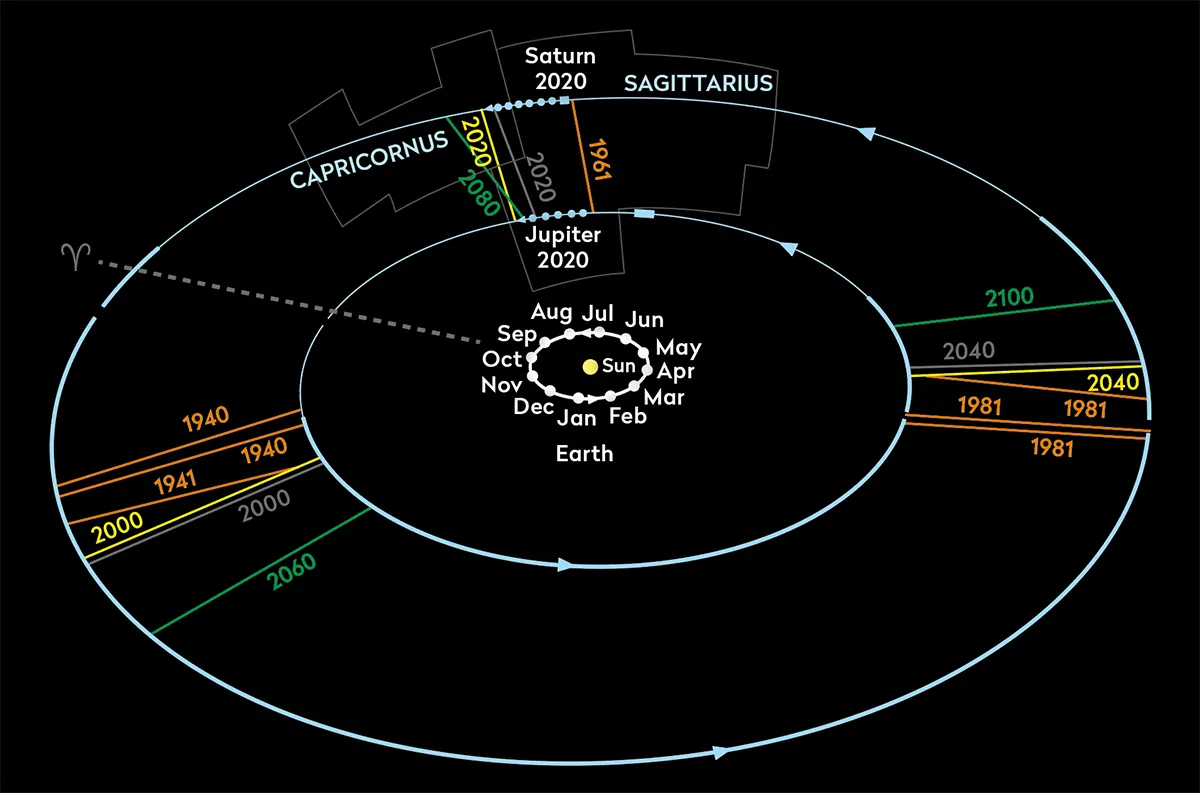
When and where to look for the Great Conjunction
The main event will have Jupiter and Saturn separated by a mere 6.1 arcminutes on Monday, 21 December, 2020.
Sunset will take place at 15:53 in London, 16:06 in Cardiff, 15:59 in Belfast and 15:39 in Edinburgh. About 45 minutes after sunset observers should look 10º above the south-southwest horizon to see Jupiter and Saturn shining almost as one.
Although the moment of closest conjunction is the highlight, try observing the narrowing separation of Jupiter and Saturn in the weeks before 21 December.
They will begin the month 2.1° apart, narrowing to 0.1º on 21 December, and as Jupiter overtakes Saturn, they’ll end 2020 around 1º apart. So for much of the month they will appear to be very, very close.
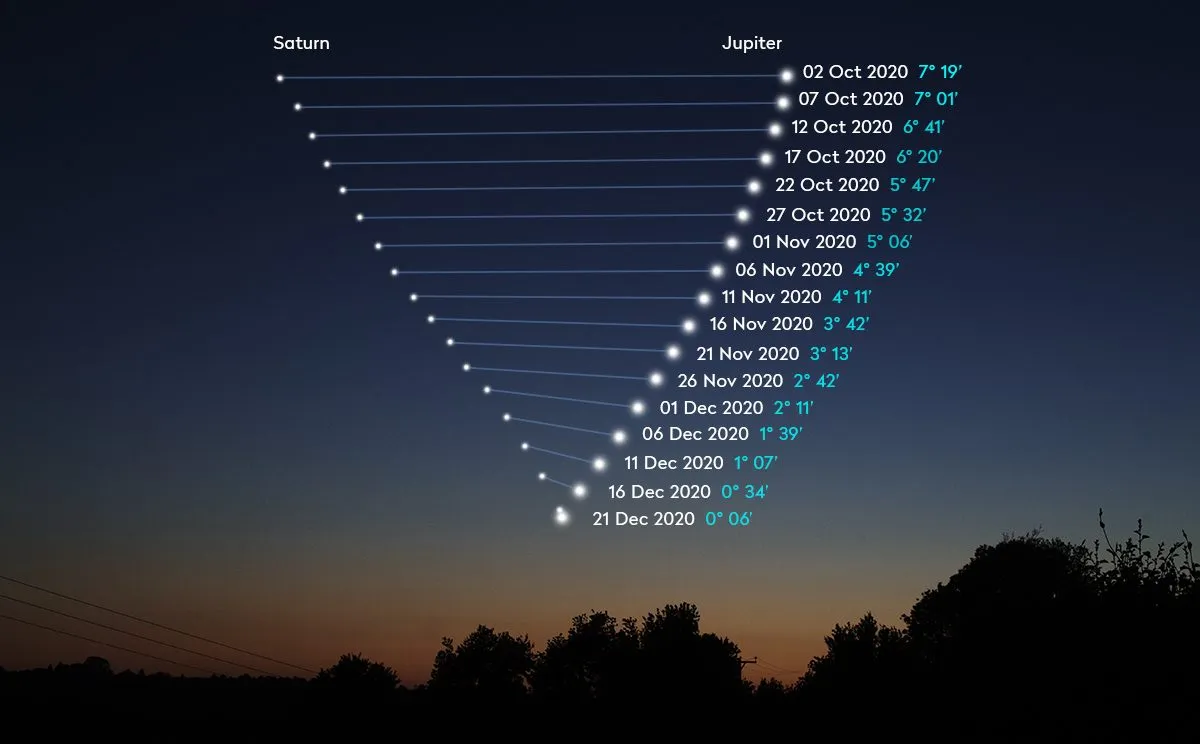
How and when to observe the Great Conjunction
Where and when you observe from will be critical. "You need to be at an observing site that has nice westward view without trees or buildings blocking the horizon," says Dorest-based astronomer Bob Mizen, author of Stargazers' Almanac: A Monthly Guide to the Stars and Planets 2021.
“The planets will be sinking all the time, so time it carefully. "The two planets will have sunk in the southwest by around 18:20, but aim to look from 16:30 when the spectacle will become visible while being at its highest in the sky.
"The ‘great solstice conjunction’ will take place just within the boundaries of the constellation of Capricorn while a 50% illuminated First Quarter Moon shines high in the south."
What you’ll see during the Great Conjunction
Though to the naked eye the planets will appear at first glance to shine as one, close study will reveal otherwise. Through binoculars, the observer will easily see Jupiter and Saturn separately in the same field of view.
Ditto a small telescope, which will only need a low-power eyepiece (around 50x) to separate the two planets in the same field of view.
It should also be possible to see Saturn’s rings, its giant moon Titan, and Jupiter’s Galilean moons Ganymede, Io, Callisto and Europa all in the same field of view.
A 200mm lens will be required to capture a photograph of the planets and possibly Jupiter’s moons in the gathering darkness.
For more on this, read Pete Lawrence's guide on how to photograph the Great Conjunction below.
Separating Jupiter from Saturn during the Great Conjunction
Also bear in mind the planets’ position relative to each other and their apparent brightness. Jupiter will be below Saturn in the southwest in the days leading up to the ‘great conjunction’, just to its lower left on the night, and above it thereafter.
While Jupiter shines at a magnitude of -1.97 during the event, Saturn will be far less bright at magnitude 0.63.
Find out more about the brightness of stars with our guide to stellar magnitude.
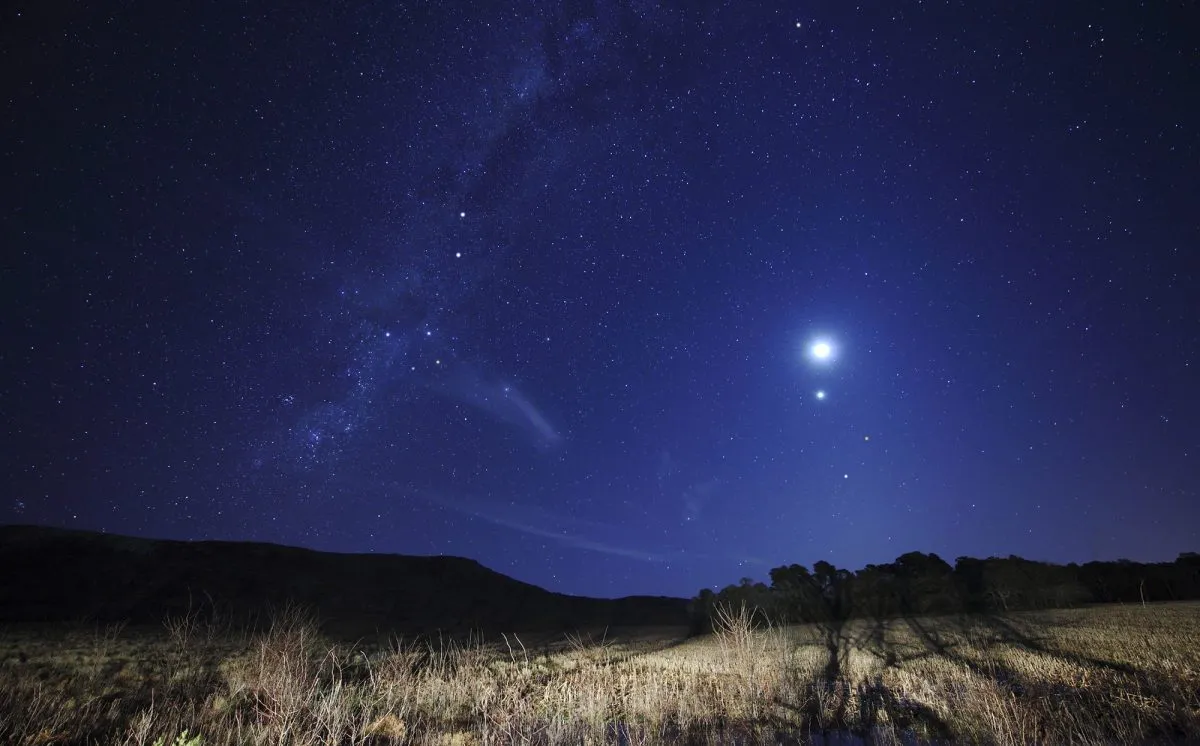
When is the next great conjunction?
It may have been a long wait for the event on 21 December, 2040, but it’s a short time – on a cosmic scale – until the next ‘great conjunction’ this close.
The good news is that Jupiter and Saturn will once again shine just 0.01º apart in the pre-dawn sky while 43.5° from the Sun in Sagittarius, so significantly higher up in a darker sky.
The bad news? That will happen on 15 March 2080.
How to photograph the Great Conjunction
Words: Pete Lawrence

If the weather plays ball, the Great Conjunction of Jupiter and Saturn will offer a chance to catch both planets as discs in a single image.
A bit of planning will pay off, because even though 6 arcminutes is fairly easy to catch using a planetary camera, it’s best to image in such a way that the 6-arcminute separation fits optimally inside the camera’s imaging frame, meaning the apparent size of each planet will be maximised for the view.
Achieving the correct imaging scale is normally done by using an optical amplifier, a device that adjusts your telescope’s effective focal length and therefore its imaging scale.
Examples of optical amplifiers include Barlow lenses, Powermates and focal reducers. Barlows and Powermates have powers which are greater than 1.
For example, a 2x Barlow lens will double your scope’s effective focal length and image scale. A focal reducer is similar but it has a power less than 1, so a 0.5x focal reducer halves your telescope’s effective focal length, giving you a wider view.
A quick way to determine the sort of image scale you will need is to use your imaging setup to image the Moon; its apparent diameter is around 30 arcminutes, so a separation of 6-arcminutes is one-fifth the apparent diameter of the Moon.
A more mathematical approach is to use the formula:
FOV (field of view) in arcminutes = imaging chip width in mm x 3,438 ÷ telescope focal length in mm
Bearing in mind we need a bit of tolerance to capture both planets’ extended families of moons, a long dimension of, say, 8 arcminutes will allow both planets and some moons to be caught. Rearranging the formula, we can calculate the required focal length as:
Telescope focal length in mm = imaging chip width in mm x 3,438 ÷ FOV in arcminutes
So, if your camera’s sensor has a long dimension of 11mm, the desired telescope focal length in millimetres is 11.0 x 3,438 ÷ 8 = 4,727mm, or 4.73 metres.
If you were using a telescope with an 800mm focal length you’d need to use an optical amplifier with a power of 5.91x to achieve the calculated optimal value.
However, as such a precise optical amplifier power isn’t available, using a 5x Powermate would suffice. Another option is a 2.5x Barlow coupled with a 2x Barlow, which might get a similar result, but may reduce the image quality a bit.
The key is to avoid exceeding the calculated value, as this may create a scale that doesn’t permit both planets to appear on chip at the same time.
Recommended equipment
- 200mm or larger telescope
- High frame rate planetary camera
- Optical amplifier
- ADC for colour cameras
- Red or luminance filter for mono cameras
Photographing the Great Conjunction, step-by-step
Step 1
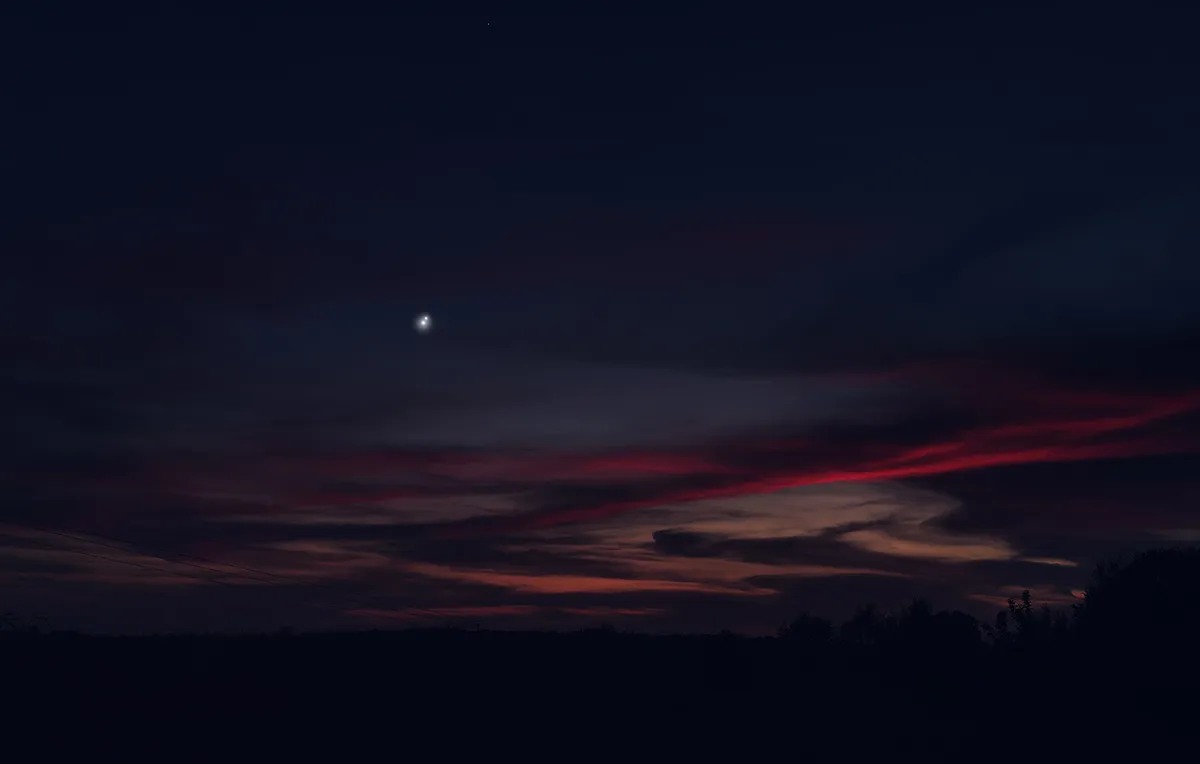
It pays to plan ahead; this is a simulation of the Great Conjunction at closest approach when it’s visible from the UK, late afternoon on 21 December. Imaging the planets with a low image scale, eg using a smartphone, will result in two close dots, but a scope will help to boost the image scale so you can see both planets as discs.
Step 2

Calculate your required focal length as: CW x 3,460 ÷ FOV, where CW is your chip’s width in mm and FOV is the desired field of view in arcminutes. Once you’ve calculated the best focal length to use, aim to achieve this by using an optical amplifier. Don’t worry about absolute precision here, just avoid going too far over what you need.
Step 3
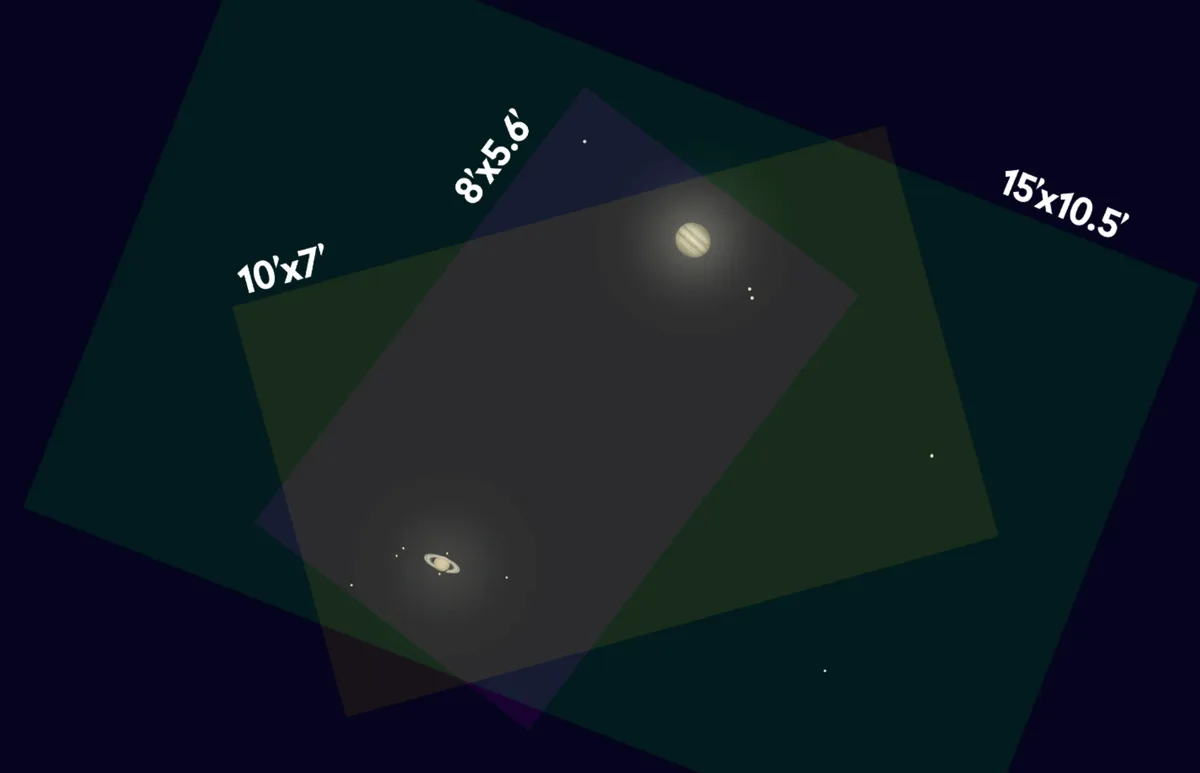
If you just want both planets and their inner moons, a field of view rectangle measuring 8 arcminutes on the long side is ideal; 10 arcminutes creates more space but may still struggle with the 7’08” separation between Europa and Ganymede. A 15 arcminutes long-side field of view will catch it all, with the two brightest field stars.
Step 4
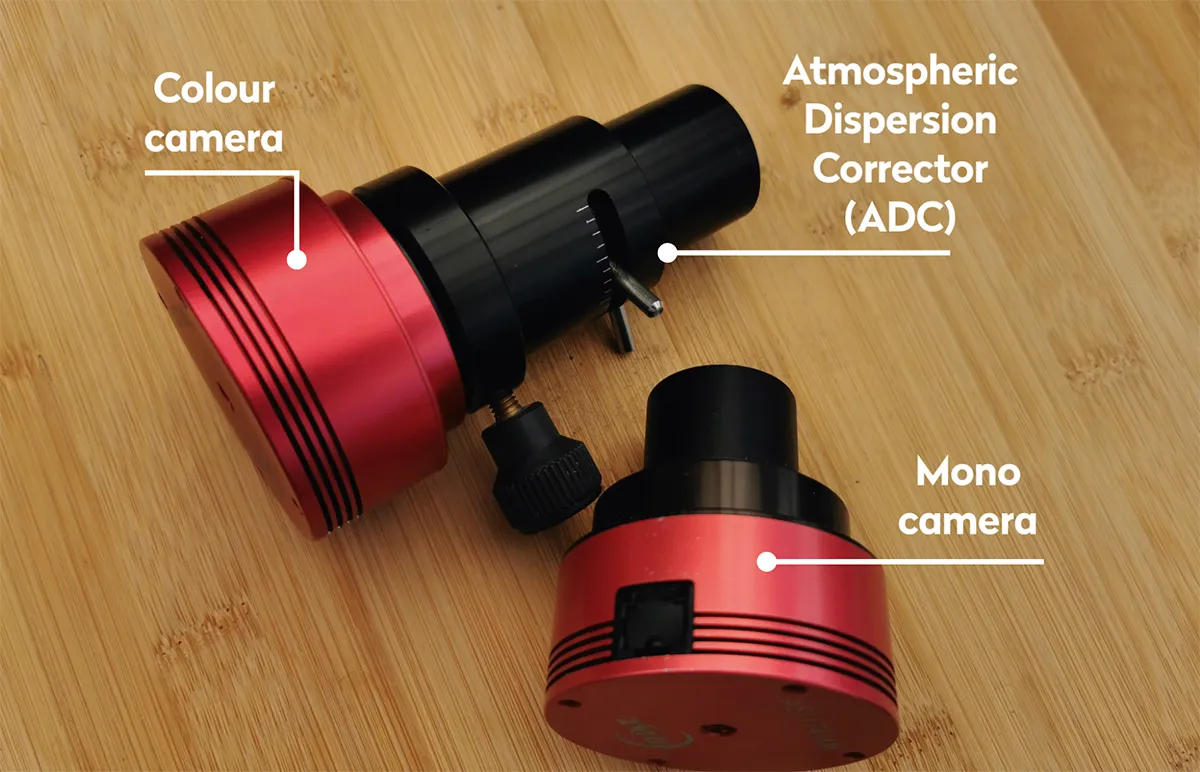
A planetary (high frame rate) camera will overcome issues of low altitude seeing affecting the Great Conjunction; a colour camera (above, top) will need an Atmospheric Dispersion Corrector (ADC) to reduce colour fringing, while a mono camera (above) using an IR pass filter will give the crispest, albeit monochrome, view.
Step 5

Set everything up and get the planets in frame. If you’re using a high image scale and things are tight, rotate the camera so both planets are on the field of view diagonal. Depending how tight your view actually is, you may lose some of the moons here. Once correctly orientated, tighten everything up and focus carefully.
Step 6
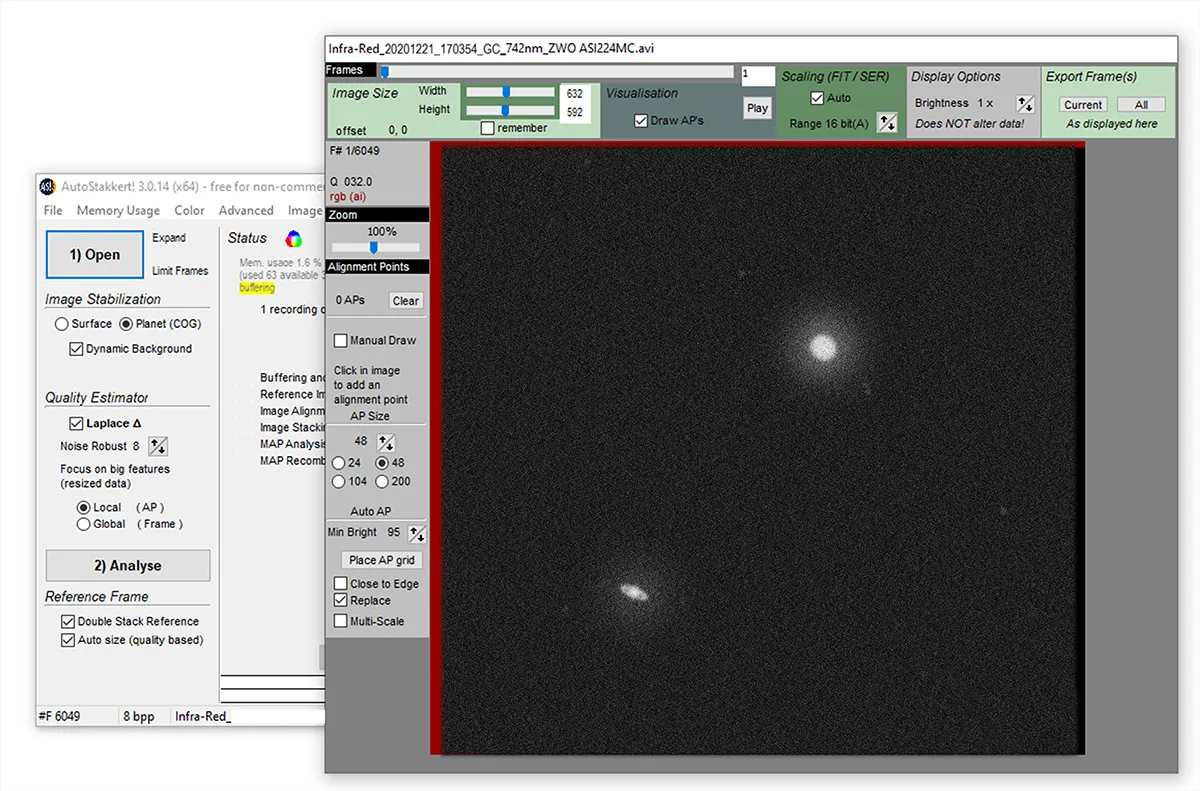
Set the frame rate high for this, all the time keeping an eye on gamma correction and keep it as low as feasible. Aim to collect 500 to 1,000 frames, limiting capture time to around a minute. Make several captures, refocusing in between for safety. Process the result in a registration-stacking program like AutoStakkert 3.
Did you manage to see the Great Conjunction, or even photograph it? Let us know by emailing contactus@skyatnightmagazine.com or get in touch via Facebook, Twitter and Instagram.

